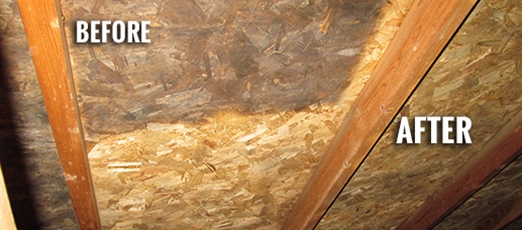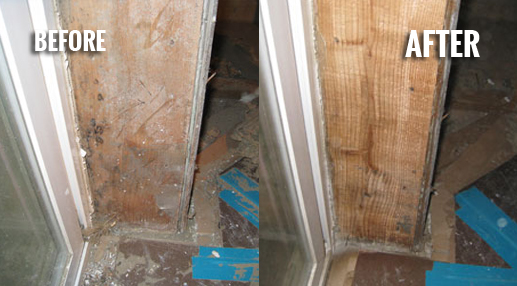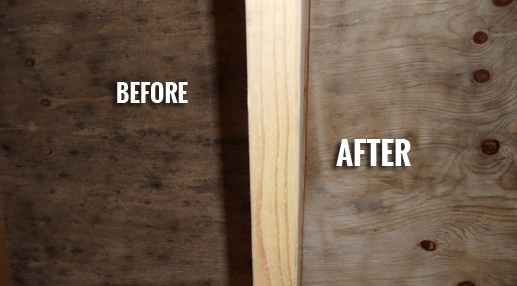Mold Remediation

Faster Than Traditional Sanding/Scrubbing
Dry ice blasting kills and removes mold spores from wood between 60 to 80% faster than traditional cleaning methods because it is capable of getting in hard to reach places such as in crevices, around nails and screws, and places that would be difficult for hands or tools to reach. The range of available nozzles for dry ice blasting equipment enables operators to access tight corners quickly, and in many cases, clear mold from areas inaccessible to hand tools, such as inside corners of wood framing trusses and joists. Dry ice can be safely blasted around wiring, plumbing, and pipe fixtures without causing damage to them. Dry ice blasting accomplishes mold remediation faster and more completely than mechanical abrasion.
Three technicians using the traditional methods of sanding, scraping and spraying a mold infested attic, would typically complete an attic job in five or six working days. However using dry ice blasting, two technicians can complete that very same job in two days. Due to the speed and effectiveness of dry ice blasting, mold removal will take a fraction of the time when compared to traditional methods. Therefore, residents have lower displacement costs and dry ice is environmentally friendly and non-toxic.
Kills Mold on Contact
Unlike other methods that simply wash away surface mold and mildew, the low temperature of dry ice (-110 degrees) kills mold and mildew on contact. Dry ice blasting quickly permeates deeply into wood and other surfaces to remove mold spores without the need for expensive and often ineffective solvents. The dry ice blasting process also eliminates the need for laborious sanding and scraping. Dry ice blasting does not require toxic chemicals and does not create a toxic dust hazard from remediation operations.
The only way to ensure mold spore removal from wood is through dry ice blasting. Crystal Soda Blast has been using dry ice to eliminate mold from wood framing for over 2 years now with great success. Every post remediation verification test performed by an Industrial Hygienist on Crystal Soda Blast jobs have been completely successful.
Benefits:
- Reduced labor hours
- Shorter clean times to allow occupancy in a shorter timeframe
- Dry ice is a non-conductor of electricity, so live electrical equipment and wiring does not have to be removed or de-energized during the remediation process
- Major reduction in secondary waste
Generates little to no dust - Elimination of expensive and potentially toxic chemicals
- Improved health quality due to the absence of mold spores and chemicals
- Improved aesthetic look of property, and longevity and quality of your structure
- Consistently passes the Industrial
- Hygienist’s post remediation verification tests
- Can kill and remove mold where hands and tools cannot
How it Works
Dry ice blasting for mold remediation uses four physical properties of air-propelled dry ice pellets:
- Velocity: Dry ice is solid (frozen) carbon dioxide. For blasting uses, dry ice is manufactured in pellets of various sizes appropriate to the substrate to be cleaned. The pellets are hurled from a blasting gun by air pressure, which provides the velocity.
- Abrasion: When the pellets strike the surface to be cleaned the velocity of the pellet strikes the substance to be removed creating abrasion.
- Thermal shock: Because dry ice is at a temperature of -109 ° F, the thermal shock helps loosen and lift the substance to be removed.
- Evaporation: The dry ice pellet flashes into carbon dioxide gas, providing more lift to the substance to be removed. When the dry ice changes from a solid to a gas, the volume expansion over surfaces such as wood, concrete or stone efficiently results in a stripping effect removing the mold from the surfaces. Dry ice sublimates and leaves no media for cleanup. The blasting process will generate saw dust, just as sanding would; however, when compared to other blasting methods, the time and cost to address the secondary waste generated by the media is eliminated.
Mold Remediation Process
Successful mold removal from a building requires the source of the mold and moisture to first be eliminated. The existence of mold in a building is the symptom of much larger problem with moisture. A mold needs food, such as wood, moisture, and a temperature range favorable to the growth of the specific mold organism. As any good contractor knows, eliminating the moisture problem is the only way to assure the mold will not return.
Once the moisture problem has been solved dry ice blasting is the best solution for removing mold. Mold can cause a great deal of health problems and can severely damage the integrity of a building's structure. So, removing the mold in its entirety is vital to any mold remediation project. Grinding, sanding, or wire-brushing to remove mold growth does not sanitize the surface and kill the mold spores without the application of a biocide which requires additional time and labor is required to apply. Dry ice blasting will almost rid the need for biocides and thus enhances worker safety, in addition to the obvious labor savings.
Once the mold infected area has been contained severely damaged carpet and drywall should be double bagged and discarded. Next, dry-ice blasting can be utilized to clean the plywood and support beams. The blasting gun can easily be managed to target the desired mark. Specific nozzle types best suited for cleaning wood can be utilized, e.g. a fan-shaped nozzle, creating a pattern several inches wide, can be used to "sweep” up and down boards and beams. The dry ice being fired on the wood can remove mold in a way that is clearly visible and in a methodical manner. Only severely stained wood will continue to show a stain but this area has been sanitized. Once the blasting phase is complete and all surfaces have been vacuumed and cleared of sawdust and other debris, mold remediators can follow up by applying an organic or micro-biocide spray to remediated areas to inhibit future growth.
The unpleasant and uncomfortable process of squeezing into tight corners to sand the mold off of wood trusses and joists, only to have mold spores remain, is soon to become a thing of the past. Dry ice blasting provides for complete spore removal from wood. This means that the use of biocides and encapsulation can be drastically reduced or eliminated, as these registered pesticides were used as a back-up method to kill and contain left over mold spores. However, dead mold is still an allergenic and must be removed which is done with a HEPA vacuum.
Chemical biocides don’t always eliminate the allergens (called metabolites) which are responsible for the allergic reactions associated with the mold. Also, biocides are typically harmful to those using them (they are not recommended for routine use by EPA or OSHA). Sandblasting is too abrasive to the underlying surface. Water and steam blasting do not provide a thorough clean and there is a greater chance of mold regeneration due to moisture. And while soda blasting provides an effective clean, it leaves behind a rather messy secondary waste stream (an issue that doesn’t come up with dry ice sublimation).
Breakdown of a Typical Attic Project:
(Note: the attic should be free of all insulation prior to our arrival.)
- Build a containment around the access and run hoses preferably outside the house.
- Spray foam (where appropriate) and put plastic over any penetrations that lead into the house.
- Dry ice blast the mold which kills the mold on contact and leaves a fine dust of wood and dead mold spores.
- Roll up all plastic in the attic for disposal.
- Use a vacuum with hepa filtration to clean the attic. Typically, we use Fiberlock AfterShock which can be brushed or sprayed on with an airless sprayer. We would use a sprayer to coat all the surfaces.
For the dry ice blasting we charge by the day and would blast the entire attic. We do this to remove and kill any non-visible mold. Then after cleaning, we go back and apply the anti-fungal with a sprayer over the whole attic to prevent future problems.
Why not just spray everything down with bleach? If you carefully read the cleaning instructions on any Tilex or Clorox productions you’ll notice that they are only good for non-porous surfaces. This is great for regular daily cleaning of the tile in your bathroom but does not work on the wood studs and plywood in your attic or crawlspace as these are porous surfaces. Bleach is mostly made up of water and the last thing you want on your wood is more moisture to give the mold something to grow on. It also doesn’t get at the "root” of the mold, nor does it remove the mold spores from the surface. The allergen remains after you are done changing the mold’s color.
Project Examples

Dry Ice- Mold Remediation
During a cold snap, this house's pipes burst causing the basement to flood. Black mold grew on the dry wall and studs. After the dry wall was removed we used dry ice to kill and remove the mold. The clean up was minimal since the dry ice sublimates on contact.

Poulsbo, WA - Residential
We used dry ice to remove mold from this residential attic in Poulsbo. In closed spaces like these, if there isn't enough ventilation, our crew will use supplied air while working.
More information on mold:
- The Dangers of Using Bleach to Kill Mold
- CDC: Dampness and Mold in Buildings
- EPA Mold Information
- California Environmental Health Investigations Branch
- Mold remediation link Coldjet
- Mold remediation Industry links Coldjet
Dry ice blasting is great for mold remediation projects and comes highly approved by industrial hygienists.
Contact Us Today for Your Free Mold Remediation Quote!
Do you have a Small Project That Needs Blasting?
If you have a movable item to blast such as a car or small boat, we recommend taking it to one of the local blast booths.

King County
Small Contracts and Suppliers
(SCS) - Certified Company
